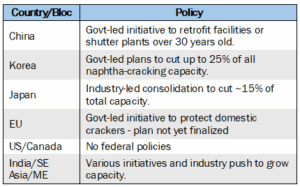Low margins and excess capacity have led to a reckoning in the global petrochemical industry. Companies in Europe and Asia are working with governments to weather the storm, and in some cases close older naphtha crackers. The streamlining reflects the superior economics of NGL-fed plants and could lead to further growth for US NGL exports.
In the Atlantic basin, the European Union (EU) is creating the Critical Chemicals Alliance to protect its domestic petrochemical industry. The new group brings together the European Commission, member states and industry stakeholders. Production sites and molecules will be earmarked for industrial policy support. The EU will subsidize chosen sites through a number of measures, including tax incentives, streamlined permitting and simplified regulations.
Europe’s petrochemical sector is in a precarious position. With a legacy fleet of crackers built to crack naphtha, the industry isn’t configured to use the cheap ethane feedstock consumed elsewhere. The continent’s economies are also mature and lack the rapid growth supporting plastics demand in other regions.
 Europe isn’t alone in facing challenges. Several governments in Asia are implementing similar frameworks to protect their petrochemical industries, while in Japan the sector is cooperating to manage a strategic retreat.
Europe isn’t alone in facing challenges. Several governments in Asia are implementing similar frameworks to protect their petrochemical industries, while in Japan the sector is cooperating to manage a strategic retreat.
China plans to retrofit nearly half the country’s total petchem capacity to increase yields, while also encouraging a shift towards specialty chemicals further downstream. South Korea plans to reduce the nation’s naphtha-cracking capacity by as much as 25%. Japan’s domestic industry, rather than its government, has taken action to reduce capacity through plant closures.
North America doesn’t have the same model of government and industry cooperation. The US has no federal policies to restrict production, although growth in petchems has slowed relative to the past. In Canada, Dow (DOW) has suspended construction of its Path2Zero ethylene plant, citing weak demand and uncertain profits.
In contrast, India, Southeast Asia and the Middle East continue to grow their capacities. Nations like Thailand, Indonesia, Malaysia and Vietnam are adding olefin capacity through new crackers or expansions. Saudi Arabia and the UAE are also adding crackers. India is perhaps the fastest-growing nation, and is backing policy frameworks that aim to boost petrochemical capacity.
What does this all mean for US NGL exports? To maintain ethylene and propylene supply, firms will lean harder on existing and new steam crackers fed by NGLs. South Korean firm YNCC is exploring retrofitting old crackers to use ethane and more LPGs. As older crackers are retired, the spread between NGLs and olefins (petrochemical margins) will likely rise and could lead to companies exploring new ethane or LPG-fed units. – Alex Albazzaz Tickers: DOW.
Meet Daley, the Best AI Tool in Energy
Meet Daley, the newest member of our energy team. Our new AI assistant is live and available to all East Daley Analytics clients. Early feedback has been phenomenal. Daley is platform-specific, and only pulls from East Daley’s own proprietary data and content. It’s not open-source or generic AI, but built to understand our structure, language and analytics. Whether you’re looking for a specific metric, forecast or explanation, Daley can get you there quicker. — Reach out to learn more about Daley!
Get the Data Center Demand Monitor
The Data Center Demand Monitor is your go-to source for tracking data center projects and demand. Available as part of the Macro Supply & Demand Report, East Daley monitors and visualizes nearly 500 US data center projects. Use the Data Center Demand Monitor to forecast demand, identify pipeline corridors and track data center projects. — Request your demo now of the Data Center Demand Monitor!
The Daley Note
Subscribe to The Daley Note for energy insights delivered daily to your inbox. The Daley Note covers news, commodity prices, security prices and EDA research likely to affect markets in the short term.




